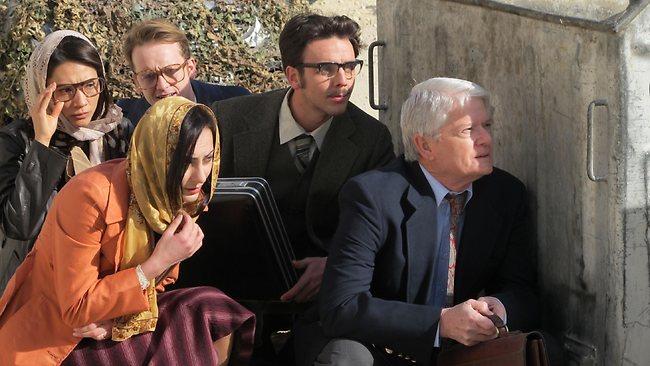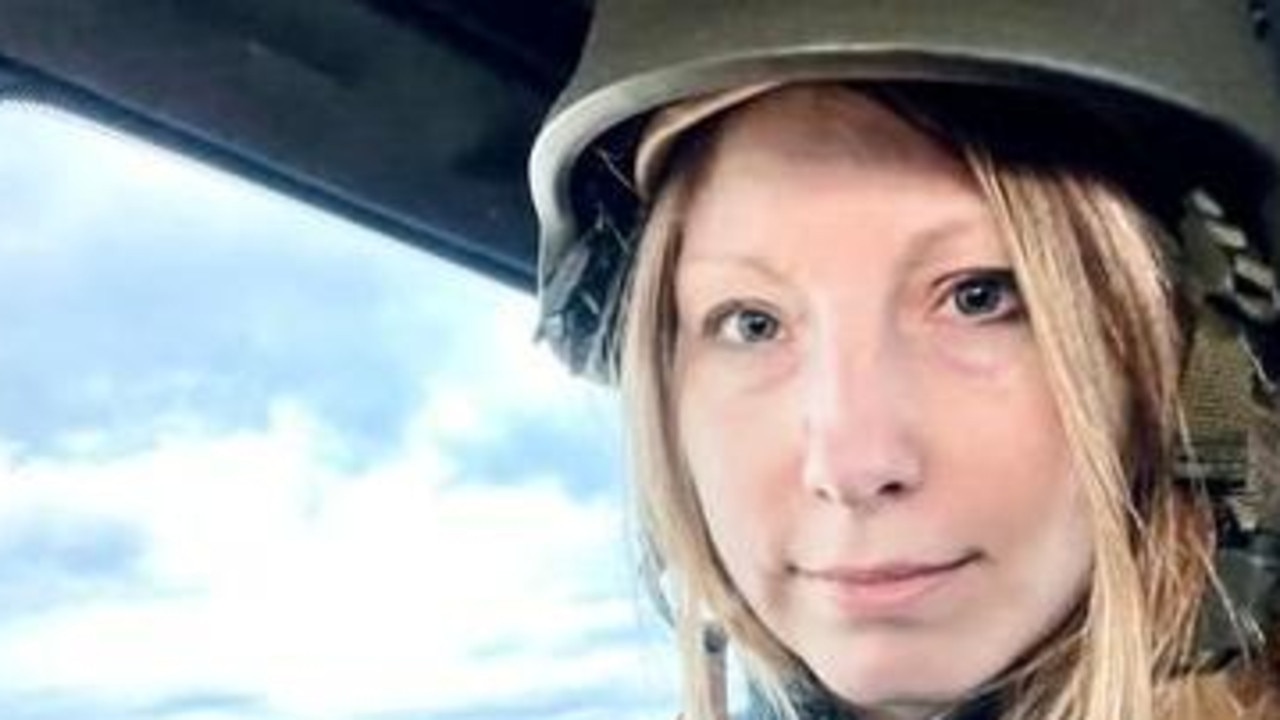Real Argo drama that enabled flight from Iran
YOU'D be hard-pressed to make up the improbable true story of the escape dramatised last year in Argo.

FOR all the deserved hoopla attached to last year's Ben Affleck film Argo - its best picture Oscar being the chief exhibit - there's a quietly amusing reminder of Hollywood's chimeric, fabricated nature in his tale of diplomatic bravery during the 1979-81 Iranian hostage crisis.
Actually, there are a couple of crackers. But neither of them appears in the drama starring Affleck as CIA disguises-and-improbable-stories expert Tony Mendez, who comes up with a scheme to pluck six fugitive American consular workers out of Tehran after revolutionaries overrun the US embassy in November 1979.
Neither do they emerge in this engaging Nat Geo documentary, told through the recollections of the real Mendez and two of the people he rescued, husband-and-wife team Mark and Cora Lijek. It's made by the British outfit behind the successful Banged Up Abroad franchise, which often features the true stories of well-meaning drug smugglers incarcerated by leering "furreners" in their "furren" jails, but sometimes gets a bit more serious in an international diplomacy kind of way.
This is one such case, and In Banged up Abroad: The Real Argo, the Lijeks give a fascinating insight into the stoicism and creativity that regular government inkpad jockeys can display when they find themselves in situations of great drama. "I'm sitting in the den, we have a little TV and we're watching the news and they're showing footage from the embassy ... they're bringing people out and they've got blindfolds on, they've got handcuffs, you can see they're - they're kind of stumbling because they can't see where they're going," Cora Lijek recalls, of the early days after her small group escaped the embassy and was hidden in Tehran by Canadian diplomats. "And it's just a horrible feeling as we're watching what's happening to them."
The hostage crisis was a drama that captivated the US, but the role played by these six staff members, as well as Mendez and another CIA agent who doesn't appear in Affleck's film, was unknown at the time.
As for the genial, bearded Mendez, in this documentary he's as far from how you might imagine a CIA agent looks as ... well, one is reminded of the reply Vladimir Putin is supposed to have given when asked by a journalist whether he really was a KGB agent: "Of course I'm not KGB agent. I look like KGB agent. Real KGB agent looks like your grandmother."
And just as not everything is all as it seems in the world of espionage, neither is it here: unless you're stuck watching The Real Argo in an airport hotel while waiting for a connecting flight and with no access to the internet, it's worth engaging in a little contextual research of your own along the way. Because for the two brilliantly illuminating moments in the audacious Argo project that give an insight into the whole sleight-of-hand that is filmmaking, you have to go beyond Affleck or the Banged Up team and straight to Mendez's own words, including in his 1999 memoir, The Master of Disguise: My Secret Life in the CIA.
Mendez - who comes across in real life as a rather more dour character than the one portrayed by Affleck (but there's the magic of Hollywood for you) - notes that, contrary to portrayals of the Tehran escape that rely on a tense, agonisingly slow early morning journey through immigration at the Iranian capital's Mehrabad airport, the final moments as played out at the time were absolutely unremarkable.
In fact, what Mendez's own account makes clear is that after a focused few days of the six Americans being coached into assuming new identities - as Canadian science fiction filmmakers, no less, with proper backstories about a fantasy film called Argo and forged Canadian passports - by the time they reached the dozy Iranian immigration official standing between them and freedom, they probably needed to have been wearing flashing red devil's horns for anything to have gone wrong.
Poised with his charges in the airport queue to intervene and, as he puts it, "overwhelm anyone standing in the way with Hollywood talk", Mendez says that in reality, "the Iranian official at the checkpoint could not have cared less. He stamped each of us out and collected the yellow [immigration] forms. One yellow form floated off his counter and was some distance away on the floor. When no one was looking, I picked it up and stuck it among my papers."
So far, so spy thriller - or perhaps not. Such a dull resolution would hardly have suited an Academy Award-winning blockbuster, and so every retelling of the tale - there have been several - has relied on at least some kind of last-minute hiccup where the mission's success hinges on an improbable series of coincidences. The Banged Up version is no exception, although its hold-your-breath moment is rather less gripping than Affleck's almost comic intercontinental phone call to a Los Angeles film lot. Essentially, it involves a bloke in the Mehrabad departure lounge reading a Farsi-language newspaper.
Perhaps even more significant than the final moments in Iran's immigration labyrinth, however, is the true fact the fake film company established in a blaze of publicity in Hollywood to give the Argo operation a veneer of credibility - and named Studio Six Productions in a nod to the little band of diplomats whose freedom it was intended to engineer - was so convincing that a young Steven Spielberg submitted a promising-looking script before the office was quietly wound up under the CIA's watchful eye.
Spielberg had had an otherworldly hit in 1977 with his Close Encounters of the Third Kind, and the Argo expedition was in part inspired by George Lucas's sci-fi masterpiece Star Wars from that same year, so it fits with the general sense of the faintly absurd that factual liberties continue to be taken in the yarn.
Just ask the Kiwis: so outraged were they at Hollywood's suggestion in the Affleck retelling that New Zealand had denied the six Americans safe haven while on the run from the revolutionary mob - false, as it turns out - they passed a motion in their parliament in March decrying the film. Take that, Great Satan!
And as the quote from Cora Lijek above suggests, the fate of those taken hostage in the embassy - the bulk of them for the full 444 days of the crisis, with the release of the 52 remaining staff coming only in January 1981 after a series of bungled US-Iran encounters on the matter - has been overshadowed just a little since the popularity of the Affleck project.
But Cora Lijek says now of those she was watching on the TV news while holed up in the home of her Canadian benefactor: "I think I just felt angry for how they were being treated. I mean, these were not students who were just taking over the embassy for a sit-in. These are terrorists and they're behaving like terrorists. I was paranoid and afraid for my life every day."
The Lijeks describe the difficulties they faced in learning their Argo roles when, as Cora Lijek puts it, "I'm not an actress. Can I do this? Am I going to be able to say I'm someone else?"
Her part was to be the fantasy film's scriptwriter, Teresa Harris, and Mark Lijek was its transportation manager. Extensive advertising and news events had already been undertaken in the US, with the scriptwriter's name in particular heavily promoted, so there wasn't to be any backing out.
As Mendez admits, the idea of devising as his cover story for the enterprise something so exotic "that no one would imagine it was being used for operational purposes" leaves a pretty wide margin for inventing stuff.
Which is where Banged Up Abroad: The Real Argo plays a useful role. Boasting little of the nuance or suspense of Affleck's feature film, it nonetheless draws a satisfying 60-minute arc through the story later dubbed the "Canadian caper", complete with some low-budget but convincing enough re-enactments of the key scenes.
Combine this with a reading of Mendez's various memoirs and some of the other dramatisations of the affair, and you have a yarn you couldn't make up. Wilfully embellish, perhaps, but not entirely make up. It shows how the six diplomats, who escaped from the US embassy mere minutes before it was overrun, have to trust that Mendez will be able to smuggle them out of the country.
Before the Argo scenario was agreed on as the best means of getting them out of the country, a couple of other potential cover stories had been proposed, including that they were a group of English teachers or that they were agricultural scientists. This we already know from the Affleck film, but it is touching hearing, several decades down the track, how it felt for the participants as they were considering the potential failure of such a high-stakes gambit.
"It was a dead serious game and the consequences for failure could be significant," Mark Lijek says. "I spent the whole day learning this character ... I just tried to memorise it the way I would a school assignment."
And the whole way along, the CIA's role had to be a silent one. The hostage crisis fast became the most bitter point in relations between the US and Iran, from which Jimmy Carter's presidency never recovered - eventually Ronald Reagan would win office, being sworn in the same day the 52 hostages were released.
But at least the Argo project provided an early good-news story, and the co-operation of Ottowa - whose ambassador, Ken Taylor, and deputy chief of mission, John Sheardown, played a key supporting role in the operation - was so significant that Washington was able to pretend for years it had had nothing to do with events. In the public eye, it was all thanks to the Canadians and their legendary affability.
Even Mendez's official decoration for pulling off the exfiltration was kept secret until the 1997 declassification of important details in the affair. At that point his version, on which Affleck's film was based, could be made public and the plan's sheer audacity - pretend Tehran location scouting, garish Hollywood film producer clothing fashion and all the rest of it - revealed. And, of course, the often colourful nature of how such enterprises are designed, with the contribution of Mendez's Hollywood make-up artist contact, "Jerome Calloway" - real name John Chambers, played in Affleck's film by the inimitable John Goodman - who is supposed to have been responsible for the knock-knock joke on which the whole endeavour's title was based. The punchline being, for anyone who still hasn't made it to the film: "Who's there? Argo. Argo who? Argo f . . k yourself."
IF you're a fan of the wildly well-read Sydneysider John Doyle but missed the beginning of his new series on the history of Australian architecture, there are still several episodes on the History Channel of his entertaining look at the topic.
Building Australia is a typically Doyle-esque appraisal of the various attempts since white settlement at creating built forms that respond to the Australian environment. He's laconic, witty and possessed of an urbane tone that suggests you'd always enjoy having a beer with the bloke and hearing what he really thinks about the Victorian terrace style.
Of course, this building caper has not always been successful - the aforementioned urban terrace often being a case in point - but there are some standout examples as well. This week's subject, the Queenslander, was an enduring reaction to the stultifying heat and humidity of the tropical climate that showed a spirit of imagination and adaptation.
In following weeks Doyle looks at the homestead, the weekender, the Federation style and, finally, the project house. Any one of them is enough to make you want to pull up a chair on the front step with a cup of tea - or an icy cold beverage - and ponder the ways we've created our surroundings.
But even more than that, he prompts the viewer to consider the actual people who have lived in the houses under consideration. Doyle is a deft hand as a living historian, animating the past with stories of the real people who dug ditches and laid rows of bricks and mortar and timber, and clawed out their little footholds to make the space around them their own.
It is possible to have a deep understanding of the mistakes and tragedies of European colonisation of the continent and still admire those people who refused to be bowed by forces ultimately beyond their control.
At least, that seems to be the only sensible way to really understand our continuing obsession with that little patch of ground on which we can erect a few walls and a roof to keep out the rain.
Banged Up Abroad: The Real Argo, Wednesday, August 7, 7.30pm, Nat Geo Adventure.
Building Australia, Tuesdays, 8.30pm, The History Channel.
Graeme Blundell is on leave.


